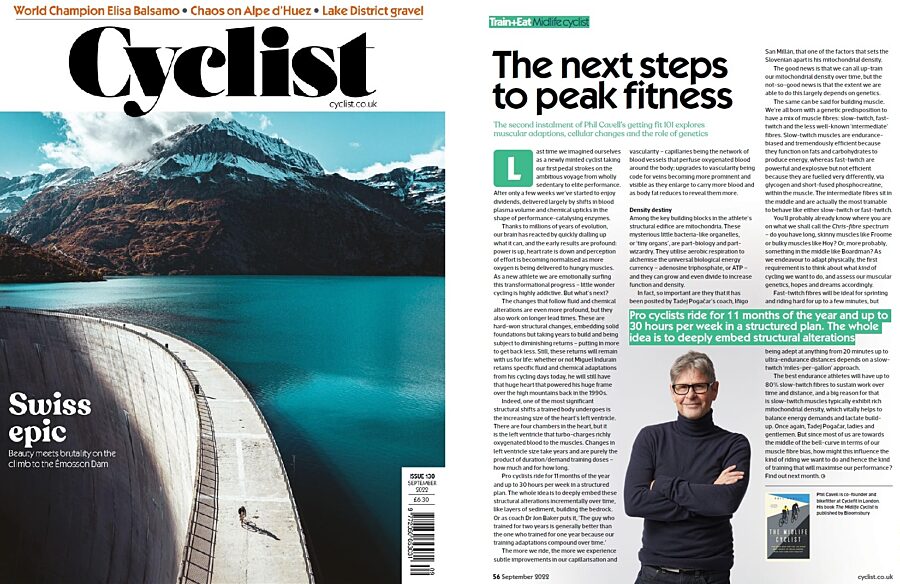"Thanks to millions of years of evolution, our brain has reacted by quickly dialling up what it can"
Fit From First principles - Part II
Last time we imagined ourselves as a newly minted cyclist taking our first pedal strokes on the ambitious voyage from wholly sedentary to elite performance.
After only a few weeks we’ve started to enjoy dividends, delivered largely by shifts in blood plasma volume and chemical upticks in the shape of performance-catalysing enzymes.
Thanks to millions of years of evolution, our brain has reacted by quickly dialling up what it can, and the early results are profound:
power is up, heart rate is down and perception of effort is becoming normalised as more oxygen is being delivered to hungry muscles.
As a new athlete we are emotionally surfing this transformational progress – little wonder cycling is highly addictive. But what’s next?
"As a new athlete we are emotionally surfing this transformational progress"
But What's Next?
The changes that follow fluid and chemical alterations are even more profound, but they also work on longer lead times. These are hard-won structural changes, embedding solid foundations but taking years to build and being subject to diminishing returns – putting in more to get back less. Still, these returns will remain with us for life: whether or not Miguel Indurain retains specific fluid and chemical adaptations from his cycling days today, he will still have that huge heart that powered his huge frame over the high mountains back in the 1990s. Indeed, one of the most significant structural shifts a trained body undergoes is the increasing size of the heart’s left ventricle.
There are four chambers in the heart, but it is the left ventricle that turbo-charges richly oxygenated blood to the muscles. Changes in left ventricle size take years and are purely the product of duration/demand training doses – how much and for how long.
Pro cyclists ride for 11 months of the year and up to 30 hours per week in a structured plan. The whole idea is to deeply embed these
structural alterations incrementally over time, like layers of sediment, building the bedrock.
Or as Performance Scientist Dr Jon Baker puts it,
‘The guy who trained for two years is generally better than the one who trained for one year because our training adaptations compound over time.’
"Pro cyclists ride for 11 months of the year and up to 30 hours per week in a structured plan. The whole idea is to deeply embed these structural alterations incrementally over time, like layers of sediment, building the bedrock"
The Athlete Emerges
The more we ride, the more we experience subtle improvements in our capillarisation and vascularity – capillaries being the network of blood vessels that perfuse oxygenated blood around the body; upgrades to vascularity being code for veins becoming more prominent and visible as they enlarge to carry more blood and as body fat reduces to reveal them more.
Density destiny
Among the key building blocks in the athlete’s structural edifice are mitochondria. These mysterious little bacteria-like organelles, or ‘tiny organs’, are part-biology and part wizardry. They utilise aerobic respiration to alchemise the universal biological energy currency – adenosine triphosphate, or ATP – and they can grow and even divide to increase
function and density.
In fact, so important are they that it has been posited by Tadej Pogačar’s coach, Iñigo San Millán, that one of the factors that sets the Slovenian apart is his mitochondrial density.
The good news is that we can all up-train our mitochondrial density over time, but the not-so-good news is that the extent we are able to do this largely depends on genetics.
"Slow-twitch muscles are endurance biased and tremendously efficient because they function on fats and carbohydrates to produce energy"
All Muscles Are not Equal
The same can be said for building muscle. We’re all born with a genetic predisposition to have a mix of muscle fibres: slow-twitch, fast-twitch
and the less well-known ‘intermediate’ fibres.
Slow-twitch muscles are endurance biased and tremendously efficient because they function on fats and carbohydrates to produce energy, whereas fast-twitch are powerful and explosive but not efficient because they are fuelled very differently, via glycogen and short-fused phosphocreatine, within the muscle.
The Chris-Fibre Spectrum
The intermediate fibres sit in the middle and are actually the most trainable
to behave like either slow-twitch or fast-twitch. You’ll probably already know where you are on what we shall call the Chris-fibre spectrum
– do you have long, skinny muscles like Froome or bulky muscles like Hoy? Or, more probably, something in the middle like Boardman? As we endeavour to adapt physically, the first requirement is to think about what kind of cycling we want to do, and assess our muscular genetics, hopes and dreams accordingly.
Fast-twitch Power!
Fast-twitch fibres will be ideal for sprinting and riding hard for up to a few minutes, but being adept at anything from 20 minutes up to ultra-endurance distances depends on a slow-twitch ‘miles-per-gallon’ approach.
The best endurance athletes will have up to 80% slow-twitch fibres to sustain work over time and distance, and a big reason for that is slow-twitch muscles typically exhibit rich mitochondrial density, which vitally helps to balance energy demands and lactate buildup. Once again, Tadej Pogačar, ladies and gentlemen.
But since most of us are towards the middle of the bell-curve in terms of our muscle fibre bias, how might this influence the kind of riding we want to do and hence the kind of training that will maximise our performance?
Find out next month
"The best endurance athletes will have up to 80% slow-twitch fibres to sustain work over time and distance"


